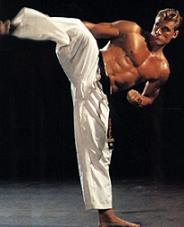HISTORY

Karate appears fearful and destructive to many people. Movies have contributed to popularizing Karate in the wrong way. There are also many people who think that Karate is only a type of calisthenics or, perhaps, even a type of dance. This shows undeniably the lack of a proper view of what Karate really is.
"Karate" is a combination of two Japanese words, "Kara" meaning empty and "Te" , meaning hand. Therefore, it is used to describe a style of unarmed combat. Karate is a martial art, it is also a way of life for many people. Through physical and spiritual training and discipline, Karate helps one in pursuing the aim of his life. It is a method of unifying the body and spirit, making human life broader and deeper.
It is generally accepted that Karate originated in India (525 A.D.), by a Buddhist priest named Daruma Taishi. Daruma Taishi, also known as Bohdidharma was the third child of a king and a brilliant student of Zen. Daruma studied the attacking techniques of animals, insects and the forces of nature. Combining these with a special breathing technique, he created the basis for a legendary system of weaponless fighting and mental concentration. Daruma created the Shao-Lin temple in China in the province of Honan and in that monastery, he taught other monks his particular style of unarmed combat.
The system developed at the temple gradually disseminated throughout Asia, spreading to Okinawa, Korea and Mongolia. By 1130A.D., aspects of this system had even been incorporated into the indigenous military disciplines of geographically and culturally isolated Japan.
The Asia fighting arts were historically taught and refined in secrecy, as their practice was routinely prohibited in different regions. Consequently, various regionally and family-based styles and schools evolved, one of these being the Kempo style of Okinawa.
By 1901, Kempo was being taught openly in Okinawa, and in 1916, was demonstrated in Japan by Master Gichin Funakoshi. There under, the name of Karate, practical applications of the system were further refined and united with the Zen-based philosophy of the Japanese disciplines. The popularity of Karate as both a martial art and a sport spread quickly in Japan and beyond, contributing to the development of diverse systems and schools.
Kyokushin Karate is a discipline through which practitioners may find clues to assist them in their own spiritual development and self-exploration. It is also a martial art encompassing philosophical considerations of life and death, struggle and survival. It is a practical form of self-defence, emphasizing (at the initial stages) kicks, punches, blocks and body movement. It is an intense physical activity, which directly benefits the individual mentally and physically.
"Kyokushin" is comprised of two Japanese words, "Kyoku" meaning ultimate and "Shin" meaning truth. The full name is Kyokushin KaiKan, were "kai" means associate, and "Kan" meaning school. The official "Gi" (Karate Uniform) used by a Kyokushin practitioner has the word Kyokushin Kai embroidered on the left side of the gi-jacket, this calligraphy is called "Kanji".
Kyokushin Karate is different from the other forms of Karate in that participants are required to go through strenuous training, conditioning and realistic contact while sparring. Kyokushin Karate believes this contact is necessary in order to fully appreciate the resiliency of the human body and spirit and to prepare for any serious confrontation.

Kyokushin emphasizes realistic combat, physical toughness and practicality in its training curriculum.
The graceful power in technique and its use of "tameshiwari" help in the development of spirit and character.
The Knockdown Karate competition system pioneered by Kyokushin has been adopted by many different Karate styles and organizations


In the Martial Arts circles, Kyokushin Karate is often referred to as “The Strongest Karate” or “Power Karate.”
It is renowned for its rigorous training and conditioning, realistic body contact in sparring, the use of tameshiwari (breaking test) technique and heavy reliance on circular motion.
This makes Kyokushin Karate rather unique compared to other Karate styles, which mainly rely on simple linear movement and non contact training. (e.g. Sports Karate)


Kyokushin was featured on Fight Quest on Discovery Channel as the Japanese Martial Arts Style.
Kyokushin was also featured on Human Weapon on History Channel as the Japanese Martial Arts Style.


